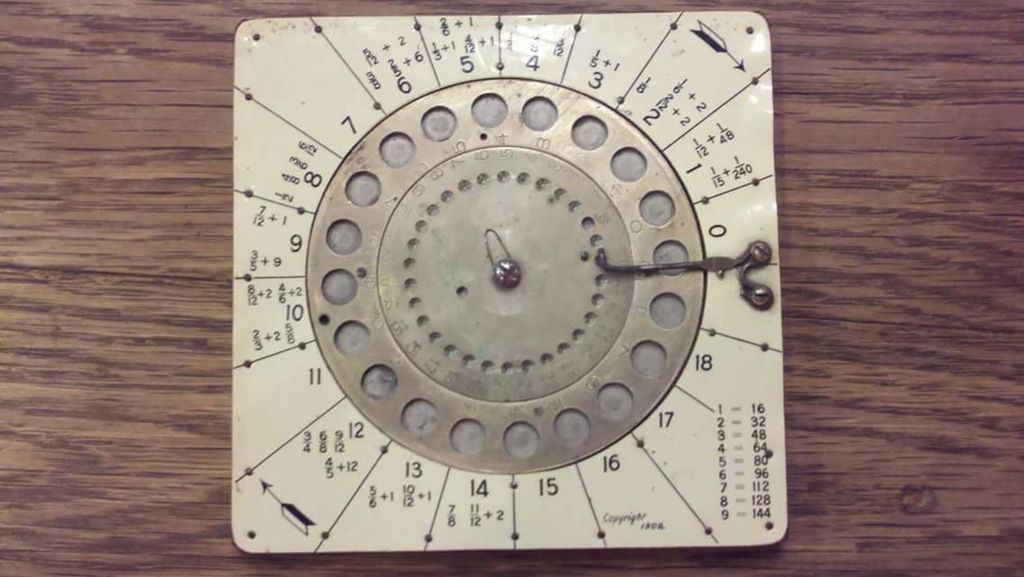Are you sure one of these didn't inspire Philip Pullman?
'
I was tempted to think weights and measures, maybe Compound Arithmetic, as the printed sectors and outer dial suggest Base-20 arithmetic (20s = £1) – count 1 to 19, then 0 and carry 1.
Yet other aspects don't quite square with Avoirdupois or £sd; and anyway, that would not explain why some sectors have more than their fair share of odd "sums" and others have none. The inner dial has 30 numbered holes – there was a 30d coin (Half a Crown, = one-eighth of a £ but I doubt that was a common factor in such arithmetic. Though all those 12-denominator fractions might (mis-?) lead us into thinking shillings & pence.
but I doubt that was a common factor in such arithmetic. Though all those 12-denominator fractions might (mis-?) lead us into thinking shillings & pence.
It is hard to see any sort of ordinary shop-keeping pattern to it all, and it would take someone more numerate than I to analyse the fractions to pick out the pattern that probably does exist – and to establish why some sectors have none.
Lets look at the progressions in 1908:
Coins & values:
1/4d, 1/2d, 1d, (2d?) 3d, 6d. Then 1s (12d), 2s (24d), 2/6 (30d), 5s (60d),
10s note. £1 (=20s = 240d), £5, £10, 20, £50 notes
Weights Avoirdupois (does that mean, "have some peas" ? )
1 ton = 20cwt. 1cwt = 4qrs. 1qr = 2 stone. 1st = 14lbs. 1lb = 16oz.
The ounce was sometimes quartered but smaller weights still were usually in apothecaries' units like grains and drachms; and didn't the jewellers have their own scale based on the Troy Ounce?
Nothing really in that lot to correspond coherently and completely with everything on that.
'
Enlarging the screen, which has now stuck on very big and won't revert, shows what I'd thought was a bit of hanging-up string is actually a detent or pawl that appears to stop the central dial with its 30 numbered hollows, from being rotated clockwise when the outer dial is turned in that direction as instructed. The flattening by its stop-pin might allow it to be raised for quickly setting the dial backwards to any particular number.
What do all those little holes round the edges do? They are too numerous for merely holding the device to a surface, and all lie on the radial lines. Or the extraneous holes in the outer movable dial.
Is that loop of wire held by the screw, a simple friction-spring, or part of a broken pointer?
'
Whilst Martin could be right about lbs and oz (fractions of 16), I am not sure that applies to all the fractions suggested – well, not without testing them all. There are a few that would correspond, such as 7/8lb (14oz); but I don't think traders and other users ever tried thirds and fifths of pounds…..
Ah! Sudden thought. Binary values (8, 16, etc). 1/3rds, 5ths…. Musical? I wonder if it had something to do with organ-building and tuning? Organ voices are referred to their ranks' fundamental pipes, which are expressed by tone name and pipe length in feet and fractions thereof; and of course, doubling the length halves the pitch. I could be well wide of the mark, but if this device is a wind-instrument calculator it might account for some of the curious values shown, and the gaps.
'
Try doing some sums with it, referred to the above, and see what you get! (I think I can still remember the basics of Compound Arithmetic, taught in Primary Schools in my day when Arithmetic was not a dirty word and Mathematics was done in Big School.)
And you thought the Antikythera Mechanism baffling?
Julian Morris.



 but I doubt that was a common factor in such arithmetic. Though all those 12-denominator fractions might (mis-?) lead us into thinking shillings & pence.
but I doubt that was a common factor in such arithmetic. Though all those 12-denominator fractions might (mis-?) lead us into thinking shillings & pence. 

